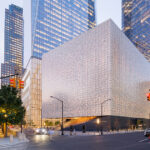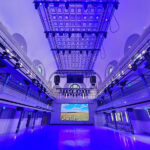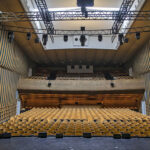Restaurateur and one-time Hollywood film producer Victor Drai has radically shifted the course of Sin City VIP nightlife entertainment multiple times over the last two decades. In a highly competitive market, Drai has proven himself to be both prolific and visionary, having established Drai’s After Hours at Barbary Coast/Bill’s Gambling Hall 15 years ago, XS at Encore Las Vegas back in 2008 and the exceedingly popular Tryst in Wynn Las Vegas, which opened in 2007.
Drai’s most recent endeavor, the indoor-outdoor Drai’s Beach Club & Nightclub, a 65,000-square-foot destination located on the rooftop of The Cromwell Las Vegas, debuted with a splash on Memorial Day Weekend, 2014.
With a maximum capacity of 4,500, eight pools, 14 dance floor tables, over 400 video tiles of different pixel pitch in constant use, more than one thousand Cove fixtures and dozens of moving light units, Drai’s might be the nightclub mogul’s most audacious and tech-driven venture to date.
“We are creating a 360-degree experience,” Drai said. “Wherever you turn, you will be awed by the design, the technology, the music, the service and, most importantly, the experience.”
 Immersion
Immersion
To help maintain his edge in the unforgiving Vegas nightlife entertainment world, Drai, a recent Nightclub Hall of Fame inductee, sought the advice and talents of Stephen Lieberman of SJ Lighting, Inc., an LD with experience designing more than 200 nightclubs.
“Victor Drai has had success building some of the most beautiful venues in Las Vegas,” says Lieberman. “What has always been a secondary focus of his directive, in the past, anyway, has been the technology systems featured in his clubs. With this venue, Victor went 180 degrees on that philosophy. He felt very comfortable with me and gave me the latitude to do what I thought was right for the space.”
 Lieberman approached the project as though he were on a mission. In a way, he was: Drai was counting on Lieberman to help make the club a success.
Lieberman approached the project as though he were on a mission. In a way, he was: Drai was counting on Lieberman to help make the club a success.
“Victor was saying, ‘I need to hire a designer who understands what is required for this marketplace, and I’m just going to let him run with the ball,’” Lieberman says.
The LD delivered in style, designing lighting and video elements for Drai’s that’s logistically sound, geometrically intricate and visually immersive. Through the use of a variety of lighting units, fixture placement, and custom video design work, Lieberman skillfully ensures that Drai’s Nightclub is open, warm and luxurious; visually gripping, but not gaudy or overwhelming.
There’s no wall of separation between the outer Beach Club area and the interior nightclub. Drai’s is simply a continuously stimulating environment that boasts both a party atmosphere and a tech-geek’s dreamspace.
“No matter where you are in the space, you should feel like you’re part of the theatrical experience, whether that involves live performers, lighting or video,” says Lieberman.
Video screens seem virtually ubiquitous on the property. According to Lieberman’s plot design, exterior video screens, positioned on the porte-cochère, measure approximately 68 feet long and nearly seven feet high. Another video screen is secured to the front of the DJ booth, which also features CO2 blasters, confetti cannons and a couple of hazers, for a combined appearance that vaguely recalls a heavily armed WWII battleship.
“There’s a lot going on in this club,” Lieberman says, in an understatement.
 Spokes-man
Spokes-man
LED video tiles line the interior walls of the club, while the space’s centerpiece (an 80-sided disco ball) is visually reinforced by a radial array of 12 large LED video tile fingers that is equally dazzling, extending out across the ceiling like spokes of a bicycle wheel.
The LED video tiles, or wheel spokes, accentuate the architectural curves of the building and also add to the sense of visual excitement, even those cavorting in the far reaches of the club. The “spokes” of this LED video wheel range in length from 29.5 to more than 47.5 feet. (Each video tile is 50cm square.) Color Kinetics’ eW Cove EC Powercore lighting fixtures run along the edges of the video fingers, defining the dimensions of the spokes. (Streamlining the installation process, a dozen Color Kinetics Data Enabler Pro units route integrated power and control commands to hundreds of Powercore units.)
 “We have LED video highlighted by LED lighting,” says Lieberman. “Since we have the Cove lighting on these spokes, if I want to turn the video off and turn the Cove lighting on, it highlights the shape of the screens. The same rule applies to other objects in the space. There’s an LED edge to practically everything.”
“We have LED video highlighted by LED lighting,” says Lieberman. “Since we have the Cove lighting on these spokes, if I want to turn the video off and turn the Cove lighting on, it highlights the shape of the screens. The same rule applies to other objects in the space. There’s an LED edge to practically everything.”
In designing the spokes, Lieberman was guided by the architectural dimensions of the club’s interior space. “With a lot of other nightclubs, everything is focused over the dance floor,” says Lieberman. “What we did was create this radial pattern that takes the video system all the way out to the walls and penetrates them, really. Video lays along the ceiling and along the wall very naturally.”
 Centralized Control
Centralized Control
It perhaps should go without saying that video content is one of the most important elements of Drai’s Nightclub’s immersive environment. A custom-made Epic 3D mapping server, built by California-based V Squared Labs, contains loads of content (nearly 1,000 clips), which can be manipulated in different ways. (Drai’s runs a second Epic server as backup.) Drai’s also created brand-based content to promote the club.
The club’s grandMA2 Light console, which acts as a master controller, operates lasers, videos and lighting and is geared toward busking rather than programming. It should be noted that choreographed shows have been cued, however. “The speed, chasing, strobing, the colors, the patterns, intensity [of lighting fixtures can be achieved with what’s right in right in front of you,” says Lieberman.
Via Cat5e, the grandMA2 console connects to an eight-port Cisco SG300 managed switch, which is linked with ETC Sensor3 SR3 48-module dimmer racks and an eight-output network processing units running into various DMX splitters located in the club’s A/V room. (A 28-port Cisco switch, which links with the aforementioned eight-port, acts as a hub for daisy-chained fixtures operated via Color Kinetics’ Ethernet-based KiNET protocol and DMX command data.) Video is run over fiber cables.
Although Drai’s employs a VJ operator, override power provides necessary redundancy when the club is short staffed. Centralized control also comes in handy when showing the system to a client. “You can do anything at a touch of a button,” says Lieberman. “When you’re running a nightclub from 10 o’clock at night until four or five in the morning you need an arsenal of equipment and content to have the night continue seamlessly without repeating yourself. This system provides that. Clips can be any color you want. We have different audio reactive effects on top of that, as well.”
 Alleyway Theatrical Lighting
Alleyway Theatrical Lighting
For further visual effect Lieberman placed theatrical lighting fixtures in the center circle located at the locus of the LED spokes. This circular space contains eight Elation Platinum Beam 5R Extremes.
The alleyways, or areas in between the spokes, contain a combination of LED Protron strobes, Platinum Spot 5Rs, Rayzor Q12s and pinspot LEDs. A quick look at Lieberman’s rigging plots reveals that the placements of lighting fixtures are often aligned in mirror-image arrays. No truss was used inside the club, and all lighting units are hung from Unistrut frames, which have been painted to blend in with the color of the ceiling to conceal their presence.
With three crucial types of moving-light units at his disposal (i.e. beams, spots and washes) Lieberman can create just about any look he desires, anywhere in the space. “Instead of everything being super edgy, electronic tech-y feel, the pinspots offer balance to bring it back to something a little more warm and a little more comfortable,” says Lieberman. “It offers a base for your effects.”
Around the parameter of the mezzanine, there’s a series of Cuepix Strip WW lights, RGB lasers and Protron strobes, which hug the semi-circular dimensions of the club’s interior. Effects, such as strobes, provide extra detail or “pop around the room,” says Lieberman. “I tell [lighting] operators and club managers, the primary purpose of strobes is punctuation at the end of a sentence. The strobes should not be a base for a lighting design. When you want those high moments, you want to give them a good crack, that’s when you hit the strobe, which, to me, is a very analog, old school discotheque fixture. Again, it’s about balance.”
 Ogling the Octacontagon
Ogling the Octacontagon
Although immersive video is impressive and, some might say, paramount in keeping clientele returning to clubs with even a modicum of frequency, what puts Drai’s Nightclub over the top is its custom centerpiece — a 1,700-pound, 80-sided (or octacontagonal) disco ball, composed of 80, 10mm specially made LED triangular-shaped video tiles.
The outer shell of this sphere is lined with 120 pieces of one-foot Color Kinetics Cove LED strip lights. Fittingly, the 80-sided polygon is composed of a series of interconnected pentagons (or star patterns), slightly recalling the LED video tile spokes, which surround it.
The eight-foot-in-diameter centerpiece is computer operated and winch-driven and can be moved up and down in the space over the dance floor. “With a couple of different cues you can basically hit a button, select a speed, and it will come down in the speed you’ve chosen,” says Lieberman.
Lieberman confesses that there’s no real significance to the centerpiece having 80 sides, but admits that the geometric shapes found on a common soccer ball were used as something of a guide. For various reasons, Lieberman kept the design of the disco ball pretty hush-hush prior to its unveiling.
“We didn’t want to let it out to the field and get away from us,” says Lieberman. “I wanted something that nobody had seen before. In order to do that, you have to design everything from scratch.”
Forty-two LED pinspots have been placed at points in which the strip lights intersect. “Those fixtures were chosen because of the way they integrate into our control system,” says Lieberman. “They were able to be assembled into the structure of the centerpiece.”
When the lights are active, the octacontagon emits beams that resemble, perhaps in the minds of some, the rays of the sun. “There are multiple layers of effects in the disco call, which I think is part of the whole intrigue of the product,” says Lieberman. “At its foundation it’s a structural piece that’s kind of monolithic, just by itself. What we wanted to do was create a central focal point and take it to the next level; take our customers to the next level and give them something to look at that’s awe-inspiring, visually entertaining, and made sense with the design of the rest of the space.”
Video content has been mapped around the sphere’s 360-degree surface. “At the same time, content can be mapped to a flat version of [the polygon], so when outside video directors visit the club, they can use content that’s appropriate for their act.”
Global Cooling
A crucial contribution to the club’s overall ambiance is its custom lighting, which, much like the video installed in the space, enhances the architectural design of the property and accents edge details, including those around the pool, the outside steps, the bankets and bottle displays, among other facets. In addition, ten tall and textured outdoor trees, each uplit with a SGM G-Spot and set against the city lights and desert night sky, evoke something far more ancient and exotic — Roman columns or the pillars of Egypt’s Karnak temple complex.
Thanks, in part, to pivotal lighting placement, the club’s indoor-outdoor concept flows naturally, contributing to the property’s inviting atmosphere. Further to this end and, as per Drai’s request, the temperature of the lights all around the property were kept “warm,” but not “hot” or intense.
“Warm lighting is what [Drai] wants everywhere,” says Lieberman “Typically, an LED strip is as warm as 2,700K, but that was too hot for him. Even the 2,400K stuff Victor doesn’t really like. So we knocked [the color temperature] down to about 2,200K with custom detail, having the manufacturer add a red LED every forth LED. Then we used some theatrical equipment over the main dance floor to light tables. Because the ceilings are so high — approaching 30 feet — using typical table lights wasn’t going to give us the throw we needed, so we used ETC Source Four ellipsoidals with drop-in irises and 375-watt lamps. Usually you might be in a club that has a 15-foot ceiling, at most. In that case you can use a 75-watt MR 16 in the track head, but we didn’t have that opportunity, here. The majority of what’s going on at Drai’s is really Cove light detail. Coves really highlighted the architecture and give the overall lighting a glow.”
It took nearly six months to map out the finer points of the theatrical and architectural lighting for the club — a circumstance that Lieberman says assisted him in drafting a harmonious and seamless design. “The nice part about having the privilege of designing the whole space, including architectural lighting, is there’s a cohesiveness to the design,” says Lieberman. “I didn’t have to worry about consulting with another lighting designer. The lighting over the table, the bar area, etc., I was intimate with all of those details, because I designed them.”
Drai’s Midas touch and Lieberman’s expertise combined to create a club that embodies comfort, style and dazzling — and surprisingly welcoming — lighting.
“[Drai] didn’t come out and say, ‘We are going to put more weight behind a lighting and video system,’” says Lieberman, “but he certainly wanted to do something different with Drai’s Nightclub. Actually, I think he swung for the fences on this and I think he hit a home run. This is certainly one of the biggest systems I’ve built to date over my career.”
Drai’s BeachClub & NightClub
Crew
Lighting Designer:
Stephen Lieberman/SJ Lighting
Video Control: V Squared Labs
Gear
Lighting:
1 grandMA2 Light console
28 Elation Platinum Spot 15R Pros
30 Elation Platinum Beam 5R Extremes
24 Elation Rayzor Q12s
32 Elation Protron LED Strobes
56 Elation Cuepix Strip WWs
72 Pinspot LEDs
4 RGB lasers (11W)
6 Kryogenifex Kryopods
1,144 Philips Color Kinetics iCove EC Powercores
12 Philips Color Kinetics Data Enabler Pros
10 SGM G-Spots (pool area)
Video:
2 V Squared Labs Epic Servers
8 DVI outputs
328 Video tiles (7mm) from AG Light and Sound
85 Video tiles (12mm) from AG Light and Sound

PLSN editor Justin Lang met with Stephen Lieberman and Victor Drai to discuss Drai’s Beach Club & Night Club. Check it out at www.plsn.com/tv.
Direct link: https://www.youtube.com/watch?v=7zz7q4gU7A4


